Isotta Fraschini
Isotta Fraschini was an Italian luxury car manufacturer, also producing trucks, as well as engines for marine and aviation use. Founded in Milan, Italy, in 1900 by Cesare Isotta and the brothers Vincenzo, Antonio, and Oreste Fraschini, in 1955 it was merged with engine manufacturer Breda Motori and renamed F.A. Isotta Fraschini e Motori Breda. The company went bankrupt in 1999. In 2000, a new company was founded as a subsidiary of Fincantieri, under the name of Isotta Fraschini Milano based in Bari.
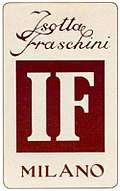 | |
| Founded | Milan, Italy (1900) |
|---|---|
| Founder | Cesare Isotta Vincenzo Fraschini Oreste Fraschini Antonio Fraschini |
| Defunct | 1949 |
| Headquarters | , |
| Products | Automobiles, aircraft engines, marine engines and other goods |
| Owner | Fincantieri |
| Website | none |
| Footnotes / references Original firm ceased automobile production 1949 | |
History
The firm was named for its founders, Cesare Isotta and Vincenzo Fraschini, who had been importing Mors and Renault automobiles as well as Aster proprietary engines since 1899.[1] The company they founded as Società Milanese Automobili Isotta, Fraschini & C. on 27 January 1900 had the stated purpose to "Import, sell, repair cars". Prior to establishing their own products in 1904, Isotta and Fraschini assembled cars very similar to Renaults, with Aster engines. They differed from the real Renaults in having a neater underslung front radiator arrangement.[2]
The first automobile bearing this marque featured a four-cylinder engine with an output of 24 horsepower (18 kW). The car, driven by Vincenzo Fraschini, appeared in several races. In 1905, Isotta Fraschini gained notoriety in the Coppa Florio, where they entered a Tipo D with a 17.2-litre (1,050 cu in) 100 horsepower (75 kW) engine. For a short time in 1907, Isotta Fraschini merged with French automobile company Lorraine-Dietrich. The firm started making race cars using this same 100 horsepower (75 kW) engine, establishing the company's reputation and giving its name considerable cachet. It was also one of the first companies to successfully market cars with four-wheel brakes, following their invention by Arrol-Johnston of Scotland in 1909.[3] They were also among the early pioneers of overhead cam (OHC), with an engine designed by Giustino Cattaneo.[4] Isotta Fraschini introduced their Tipo 8, the first production automobile to be powered by a straight-eight engine, at the Paris Salon in 1919[5] and began delivering them to customers in 1920.[6]
With the growth of the wealthy middle class in North America in the 1920s, Isotta Fraschini marketed deluxe limousines to the new American aristocracy. Early film stars Clara Bow and Rudolph Valentino drove Isotta Fraschinis. A 1929 Tipo 8A Castagna Transformable is featured in the 1950 film Sunset Boulevard[7] and another appears in the 1934 film Death Takes a Holiday with Fredric March. An Isotta Fraschini also makes a featured appearance in the 1946 film Without Reservations with John Wayne and Claudette Colbert. Also, an Isotta Fraschini was gigolo Lindsay Marriott's car in Raymond Chandler's book Farewell, My Lovely (1940) that was made into the motion picture Murder, My Sweet (1944), starring Dick Powell and Claire Trevor. The grille of the Isotta Fraschini with the lightning bolt insignia is seen parked in a ravine, right before Lindsay Marriott gets zapped to death. An oversized Isotta Fraschini is also the vehicle of choice for Dick and Nicole Diver in F. Scott Fitzgerald's 1933 novel Tender is the Night.
Seriously affected by the economic crisis of the 1930s and by the disruptions of World War II, Isotta Fraschini stopped making cars after the war (1949). Only five of the last model, the Monterosa, were produced. The plants were converted to produce marine engines.
The company was left on the company register and in 1955 it was merged with engine manufacturer Breda Motori and named F.A. Isotta Fraschini e Motori Breda. The company started to produce trolley buses again and in the 1960s built a new diesel engine factory in Bari. In the 1980s, the company was renamed Isotta Fraschini Motori SpA and it became part of Fincantieri group, with administrative headquarters in the old factory in Bari.
In the 1990s, attempts to revive the automotive industry of Isotta Fraschini were made. Concept-car coupe and roadster Isotta Fraschini T8 were built in 1996, and concept-car roadster Isotta Fraschini T12 was built in 1998. The company never went into production and closed for bankruptcy in 1999.
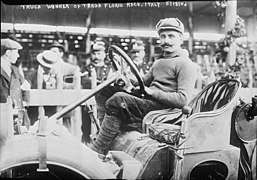 Vincenzo Trucco won the 1908 Targa Florio with Isotta Fraschini type I.
Vincenzo Trucco won the 1908 Targa Florio with Isotta Fraschini type I. AN 20/30 (1909)
AN 20/30 (1909) KM4 Tourer (1913)
KM4 Tourer (1913)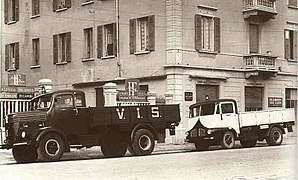 D80 (left) and D65 (right)
D80 (left) and D65 (right)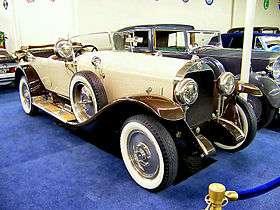 Tipo 8 Sala Phaeton
Tipo 8 Sala Phaeton Tipo 8A S LeBaron Boattail Roadster (1928)
Tipo 8A S LeBaron Boattail Roadster (1928)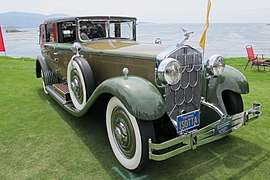 Tipo 8A Castagna Imperial Landaulet (1928)
Tipo 8A Castagna Imperial Landaulet (1928).jpg) Tipo 8C Monterosa Boneschi Cabriolet Prototype (1948)
Tipo 8C Monterosa Boneschi Cabriolet Prototype (1948)
Aero-engines
- Isotta Fraschini A.120 R.C.40 – (inverted version of Asso XI)[8]
- Isotta Fraschini L.121 R.C.40 – (version of Asso XI)[8]
- Isotta Fraschini L.170
- Isotta Fraschini L.180 I.R.C.C.15/40 inverted W-18[8]
- Isotta Fraschini L.180 I.R.C.C.45 inverted W-18[8]
- Isotta Fraschini Asso 80[9]
- Isotta Fraschini Asso 80 R.I.
- Isotta Fraschini Asso 120 R.C.40[8]
- Isotta Fraschini Asso 200
- Isotta Fraschini Asso 250 probably misidentification or variant of Asso 200
- Isotta Fraschini Asso 500
- Isotta Fraschini Asso 500 AQ
- Isotta Fraschini Asso 750[8] (140x170=47105cc/2875cuin)
- Isotta Fraschini Asso 750 R
- Isotta Fraschini Asso 750 R.C.
- Isotta Fraschini Asso 750 R.C.35[8]
- Isotta Fraschini Asso IX
- Isotta Fraschini Asso IX R.C.45
- Isotta Fraschini Asso 1000[9] (150x180=57256cc/3494cuin)
- Isotta Fraschini Asso Caccia
- Isotta Fraschini Asso XI
- Isotta Fraschini Asso (racing)
- Isotta Fraschini Beta
- Isotta Fraschini Beta R.C.10
- Isotta Fraschini Gamma[9]
- Isotta Fraschini Gamma R.C.15I
- Isotta Fraschini Gamma R.C.35IS
- Isotta Fraschini Delta[9]
- Isotta Fraschini Zeta[9]
- Isotta Fraschini Zeta R.C.25/60
- Isotta Fraschini Zeta R.C.35
- Isotta Fraschini Zeta R.C.42
- Isotta Fraschini Astro 7 C.21[8]
- Isotta Fraschini Astro 7 C.40[8]
- Isotta Fraschini Astro 14 C.40
- Isotta Fraschini Astro 14 R.C.40[8]
- Isotta Fraschini V.4[10][9]
- Isotta Fraschini V.5[10][9]
- Isotta Fraschini V.6[9]
- Isotta Fraschini 245hp[10]
- Isotta Fraschini K.14
- Isotta Fraschini 80 R
- Isotta Fraschini 80 T
Vehicles
Passenger cars
Trolleybuses
- TS 40F1
- F1
Today
Isotta Fraschini is today represented by the following three economic entities.
- Intrepida Fides, The Isotta Fraschini Foundation, acronym coined by Gabriele D'Annunzio, with registered office in Milan.
- Isotta Fraschini Milano s.r.l., with registered office in Milan, active in the field of vehicles, as well as production and marketing of luxury goods.
- Isotta Fraschini Motori S.p.A.: with registered office in Bari. An engineering firm specializing in diesel products, particularly marine engines, industrial engines, and rail traction engines, but also providing civil and military engineering products and services. The company is part of Fincantieri group. The company produces propulsion and generation systems, used in US Navy littoral fast attack surface ships and yachts. The L1306 T3, V 1312 T3, VL 1716 T2 T3 and GE COLZA V 1312 T3 generation systems produce between 200 kW and 3,000 kW. The largest of these generators are used in the Freedom class of Littoral Combat Ships.
References
- Nicholson, Tim (May 1971), Isotta-Fraschini: the noble pride of Italy, New York, NY: Ballantine Books Inc., p. 18, ISBN 0-345-02289-0
- Nicholson, p. 19
- Georgano, G. N. Cars: Early and Vintage, 1886-1930. (London: Grange-Universal, 1985)
- Georgano. They were joined by Austro-Daimler's Prinz Heinrich, designed by Ferdinand Porsche, W. O. Bentley (in 1919), and Sunbeam (between 1921 and 1923).
- Posthumus, Cyril (1977) [1977]. "War and Peace". The story of Veteran & Vintage Cars. John Wood, illustrator (Phoebus 1977 ed.). London: Hamlyn / Phoebus. p. 70. ISBN 0-600-39155-8.
- Daniels, Jeff (2002). Driving Force: The Evolution of the Car Engine. Haynes Publishing. p. 48. ISBN 1-85960-877-9.
- "ISOTTA FRASCHINI mod. 8 A". museoauto.it. Archived from the original on 13 May 2013. Retrieved 1 December 2012.
- Jane's All the World's Aircraft 1938. London: Sampson, Low & Martin company Limited. 1938.
- Gunston, Bill (1989). World Encyclopaedia of Aero Engines (2nd ed.). Cambridge, England: Patrick Stephens Limited. ISBN 1-85260-163-9.
- Grey, C.G. (1969). Jane's All the World's Aircraft 1919 (Facsimile ed.). David & Charles (Publishing) Limited. pp. 1b to 145b. ISBN 07153 4647 4.
External links
| Wikimedia Commons has media related to Isotta Fraschini. |